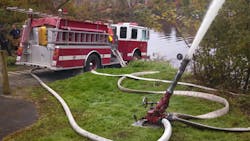Ballam: What's In Your Station
There’s a commercial on TV that asks: "What’s in your wallet?" The premise is, what can you count on when you really need it.
It got me thinking about another question more relevant to us in the fire service. "What’s in your station?"
When stuff happens, the stuff in our firehouse, particularly apparatus, has to work. It has to get us there, it has to pull all our tools and it has to pump water – basic ingredients for fire suppression.
That’s why a few members of my department spent Saturday having our pumps tested to National Fire Protection Association (NFPA) standards by a third-party, independent agent. We wanted to know that what we have in our station was going to perform as expected when needed.
NFPA says pump testing should be done every year on all apparatus, but if we’re honest, I’d bet there’s a bunch of departments who don’t do that. Our department is among them. Last time we had it done by a third-party, certified pump tester, was three years ago. And that’s because some guy in a pickup truck, who pretended to be a pump technician said our 20-year-old midship pumper needed a complete overhaul to the tune of more than $10,000. We didn’t believe him and an official pump test proved it. We have a new person checking our pumps now.
Anyway, our 1990 engine and our 2003 pumper-tanker, both with 1,250 pumps passed the test on Saturday with proverbial flying colors, both substantially exceeding their rated capacities, something that all well-maintained and operated pumps ought to do easily.
Maintaining apparatus, and all equipment for that matter, should be a priority of every department. We all can’t have brand new stuff, but we should be able to keep our stuff in good nick and have it perform as if it were new. We have an obligation not only to our members, but to the public we serve.
A member of the public approached us during our testing, asked us what we were doing and was pleased to know not only did the practice of formalized pump testing exist, he was more impressed and pleased that his local department was doing it. He wasn’t so pleased the church baptism that brought him to the remote site was delayed by nearly 40 minutes as we finished the test in progress, but that’s another story.
In our department, we know new apparatus doesn’t come often and when it does, it’s at great expense. So, we’ve decided it’s best to spend a Saturday and a few hundred dollars to know for sure what we have in our station and take care of any problems the testing may have revealed. We want to know what we have in our station will do its job when we need it most.
Do you know what’s in your station? It might be time to take a peek.
